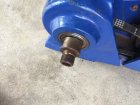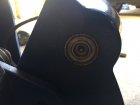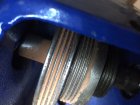Hello all,
I have a Record Power RPML 300 c mini lathe. I am trying to remove the headstock spindle (I think it's called?). The reason I am doing this is because the machine has some rust on it, and I would like to get rid of it before it eats away at the metal too much, especially on the gears. I'll attach two pictures, both of the spindle on the outside and inside (where a center or chuck would go). I don't see a centering ring or anything else keeping it in place so I think it's ready for a whack to pop it out, however I don't want to go smashing it until I'm as sure as possible that it's actually ready to get pounded out. Thanks in advance for any and all help. So I'm just hoping to discover from you all friendly people on here if it is ready for a hammering out. Thanks again.


I have a Record Power RPML 300 c mini lathe. I am trying to remove the headstock spindle (I think it's called?). The reason I am doing this is because the machine has some rust on it, and I would like to get rid of it before it eats away at the metal too much, especially on the gears. I'll attach two pictures, both of the spindle on the outside and inside (where a center or chuck would go). I don't see a centering ring or anything else keeping it in place so I think it's ready for a whack to pop it out, however I don't want to go smashing it until I'm as sure as possible that it's actually ready to get pounded out. Thanks in advance for any and all help. So I'm just hoping to discover from you all friendly people on here if it is ready for a hammering out. Thanks again.



